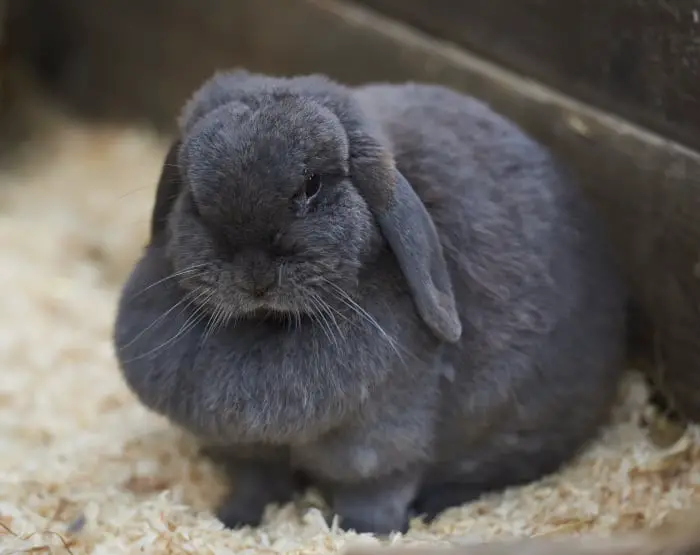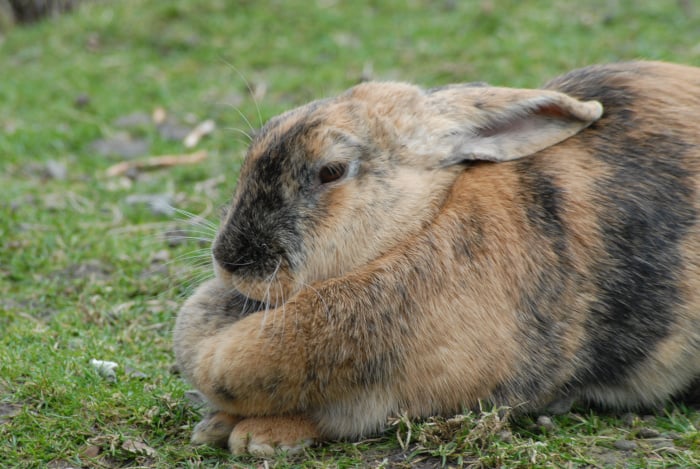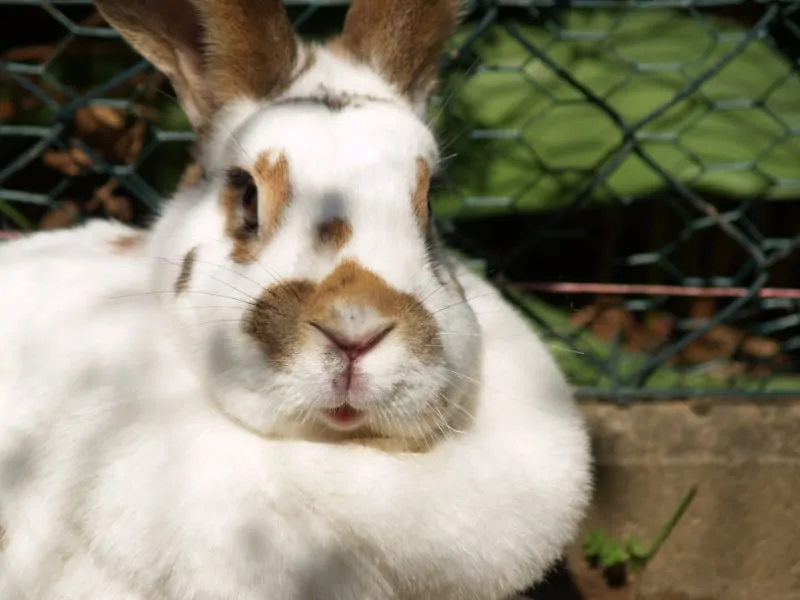If you are a reasonable observer, probably you will have noticed that some rabbits have thin and stylized necks, while others don’t seem to have any, as it looks wrapped in a thick roll of fat. So the question is why do rabbits have a dewlap?
This bump does not mean that the rabbit is sick or overweight; it is merely its dewlap. Let’s find out more.
Let Us Review What Is a Dewlap
Before we see the reason for having a dewlap, let us first determine what a dewlap is? A dewlap is a set of skin folds that hangs beneath the lower jaw or neck of a doe. It is entirely normal for a rabbit to develop a dewlap, and we should not worry about it unless it becomes substantial.
Dewlaps are not exclusive to rabbits. Many other animals develop them as well.
Why Do Some Rabbits Have Dewlaps, and Others Do Not?
We must make clear that not all rabbits have dewlaps. Its development will depend on the breed and the genetics of the rabbit. In general, small breeds do not have a dewlap.
To meet breeding standards, the females of certain breeds need to have dewlaps. These breeds include the Californians, the French Lop, and the Flemish Giants, which are rabbits with looser skin. Although male French Lops may have a small dewlap, this is not favorable among breeders.
Many other breeds are allowed to have dewlaps, but this feature is not necessary for breeders.
Main Characteristics of a Dewlap
Some people worry when their pet rabbits begin to develop a dewlap because it looks like a small bump on their neck, and sometimes, we may even think it is a developing tumor. Well, it is entirely normal for certain breeds to develop dewlaps, but if you can feel a lump in your bunny’s neck region, you should take it to the vet, as the rabbit may have an abscess.

Dewlaps can be of different sizes. In general, lop rabbits and large breed rabbits tend to have larger dewlaps. The dewlap may not be as noticeable in smaller breeds or may have a similar appearance to a double chin.
In some larger breeds, the dewlap may grow so much that it can completely encircle the animal’s neck.
Why Do Rabbits Have Dewlaps?
The purpose of the dewlap is directly related to the nesting period. The doe will develop dewlaps to help when it comes time to make a nest for babies. She will begin to prepare a nest for her future babies and use the dewlap fur to line the nest, making it warm, soft, and comfortable. The dewlap provides an excellent spot for a bunny to pull out this fur during her nesting stage, although she can also use hair from her front legs and chest.
The development of a dewlap is more common in female rabbits. The doe begins to develop its dewlap when it reaches sexual maturity and is ready to procreate. Sexual maturity occurs around 4 to 6 months of age.
If you get your doe spayed at an early age, its dewlap will be less pronounced. On the other hand, if the bunny does not get castrated, the dewlap will begin to appear and will continue to grow slowly over a year or two.
This behavior is entirely normal, but if you notice an excessive pulling of fur, especially if it leads to damage to the underneath skin, you should consult your vet.
Fake Pregnancies
Unspayed rabbits sometimes have false pregnancies as well. This behavior can occur when a rabbit is in heat. The doe will begin to pull out its fur and build up the nest even if it is not pregnant. You can still witness this behavior, although there are no male rabbits in the house and, therefore, no possibility of having rabbit babies.
Do Male Rabbits Can Have Dewlaps?
The answer is yes. Although it is not common, male rabbits can also develop a dewlap, but it is often much less pronounced than females.
Usually, if a buck develops a dewlap, it means it has higher estrogen levels than other male rabbits and is therefore these bucks are not used for breeding purposes.
Although other reasons may exist, usually higher estrogen levels can result from having the male neutered before puberty.
Rabbits that gets neutered after puberty develop much smaller dewlaps, if they develop them at all, as they are more likely to have reduced estrogen levels.
The development of a dewlap in a male can also be an indicator of overweight.
If My Bunny Develops a Sizeable Dewlap, Does It Means It is Overweight?
The truth is that the more overweight a rabbit is, the more prominent its dewlap will be. However, even though fat rabbits are more likely to have dewlaps, having it does not necessarily mean a rabbit is overweight.
Unspayed female rabbits, larger breeds of rabbits, and rabbits with looser skin are more likely to have dewlaps than other types of rabbits, whether they are overweight or not.
How Do You Know if Your Bunny’s Dewlap Is Typical or if It Is a Result of Being Overweight?
If you have ever observed a wild rabbit, you will have noticed that their bodies are thin, healthy, and muscular. The silhouette of a rabbit which possesses a healthy weight should be like these characteristics. However, you should always be aware of the features of each breed.
A rabbit with a healthy weight should be thin and muscular, and you should feel its ribs when you pet him.

Signs of Obesity
Besides the physical aspect, there are certain behaviors and characteristics which can be indicative of a rabbit being overweight. If you suspect that your rabbit is a bit pudgy, you should pay attention to any of the following signs:
- Lack of hygiene: Rabbits are spotless animals by nature. They love to spend much of their time grooming themselves. If you were to notice a lack of hygiene, this is one of the principal indicators that your rabbit has overweight problems. An obese rabbit finds it much more difficult to reach and groom all its body areas, especially the hindquarters and the lower back.
- The rabbit stops eating its cecotropes as its dewlap is so prominent that it impedes the rabbit from eating them.
- Its head gives an aspect of being much smaller in proportion to its body.
- We begin to appreciate that the width of its body is almost the same size as its length.
Any of these characteristics can be indicative of obesity. If you notice any of them, do not hesitate to consult your veterinarian. If your rabbit’s dewlap is too prominent because of obesity, you will probably need to adjust your rabbit’s diet.
When dewlaps become extremely big, and they begin to pose a problem, they may even require surgery.
What if My Bunny’s Dewlap is too Prominent?
If a rabbit presents a dewlap that is too big, at times, this can represent some problems. First of all, the rabbit will have a little more trouble grooming itself. If this happens, you will need to assist with its grooming.
Also, a very large dewlap can create problems for your rabbit when eating or drinking, which causes your pet to develop matted fur and debris stuck into their fur. Suppose this happens each time the rabbit feeds or drinks, it can lead to the appearance of skin irritations or the proliferation of fungus and bacteria on their skin, which will culminate in infections and the development of a foul smell.
We can prevent these issues from occurring by providing these rabbits a large rodent water bottle, instead of a drinking bowl.
It is also essential to keep your rabbit’s teeth in good condition as dental problems can cause excessive drooling, which will again moisten its dewlap.
How to Prevent Wet Dewlaps
The most effective way to prevent your bunny from acquiring dermatitis and dewlap infections due to a wet dewlap is to keep the area dry and free of food residues. Here are some tips:
- Trim the fur and brush the dewlap area frequently to allow it to dry faster.
- Use water bottles instead of drinking bowls and make sure they do not leak.
- Clean your rabbit’s cage frequently and remove any dirty and bedding as soon as it gets wet.
- Prevent dental problems by offering your rabbit an unlimited supply of hay and chew toys. If necessary, seek your vet for assistance in trimming its teeth.
- You must brush your rabbit’s dewlap regularly to keep it dry and mat free in case your bunny is having trouble grooming itself.
It is necessary to remain alert to these details. It is better to be safe than sorry.
To Sum Up
On a large scale, here is a brief list of the most well-known facts about dewlaps:
- Dewlaps are more frequent in mature females, although some bucks may have small dewlaps.
- Although they look like a roll of fat, dewlaps consist of a set of skinfolds.
- Their primary purpose is to pull out fur to line the nest.
- The older the female, the larger her dewlap will be.
- Dewlaps can begin to develop between 4 and 6 months of age.
- Obese rabbits also tend to have large dewlaps.
- Dewlaps tend to become much less pronounced when we spay the dow at an early age.
Whatever their purpose, the truth is that dewlaps add a more charming look to our furry friends. Who hasn’t feel tempted to cuddle that adorable furry neck?

